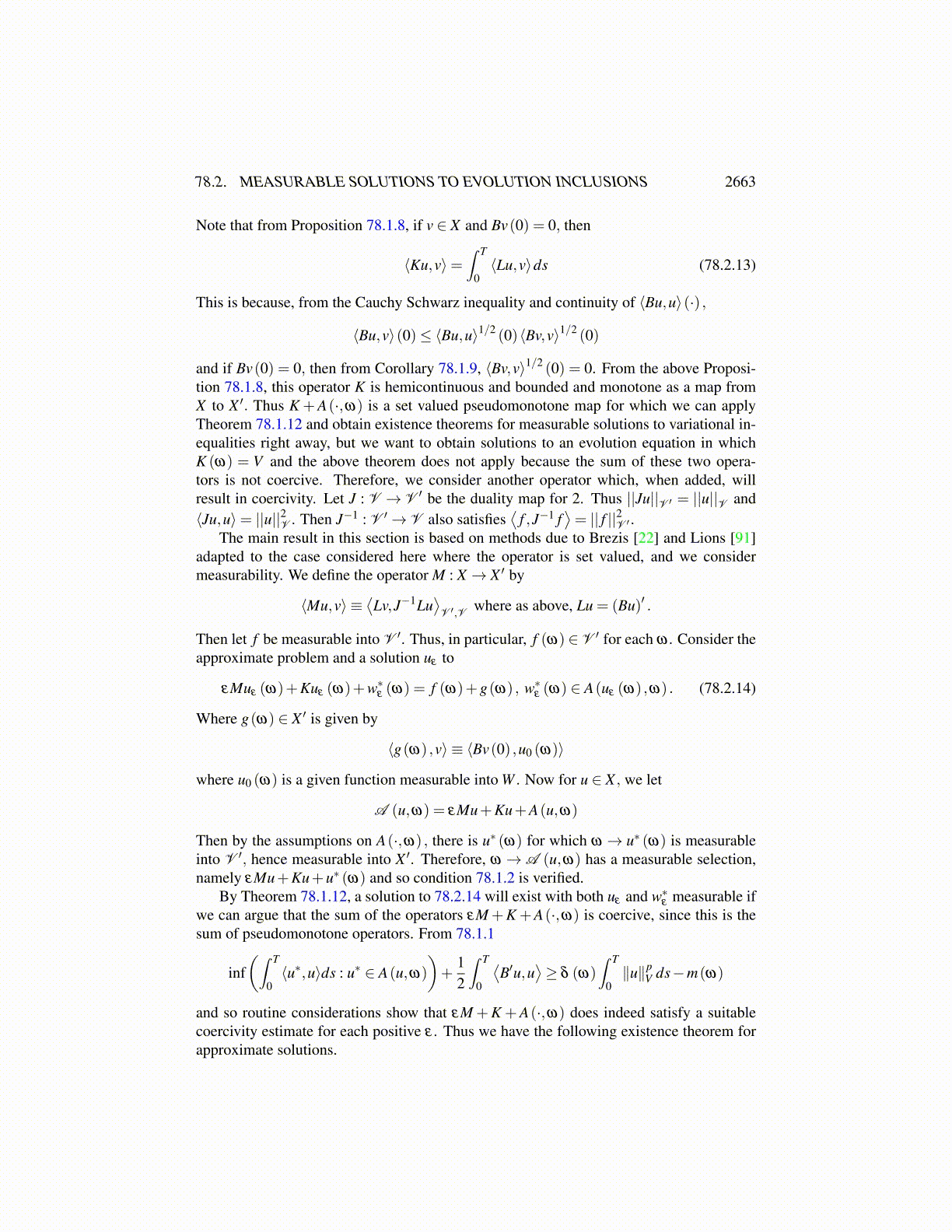
78.1. SUMMARY OF THE PROBLEM 2663
and so ξ = (Bu)′ because this is what is meant by (Bu)′. Hence L is indeed closed and Xis a Banach space. It is also a reflexive Banach space because it is isometric to a closedsubspace of the reflexive Banach space V ×V ′. Also, the following is useful. See Theorem34.4.7 on Page 1193.
Theorem 78.1.10 If Y denotes those f ∈ Lp ([0,T ] ;V ) for which f ′ ∈ Lp ([0,T ] ;V ) , sothat f has a representative such that f (t) = f (0) +
∫ t0 f ′ (s)ds a.e. t, then if ∥ f∥Y ≡
∥ f∥Lp([0,T ];V )+ ∥ f ′∥Lp([0,T ];V ) the map f → f (t) is continuous in the sense that ∥ f (t)∥ ≤C (∥ f∥Y ).
We also have the following general theory about existence of measurable solutions toelliptic problems. First are conditions which a nonlinear set valued map should satisfy.In what follows, X denotes a reflexive separable Banach space with dual X ′, (Ω,F ) is ameasurable space, and A(·,ω) : X→P (X ′), for ω ∈Ω, denotes a set valued operator. Wemake the following assumptions on such an operator:
• H1 Measurability condition. For each u ∈ X , there is a measurable selection z(ω)such that
z(ω) ∈A (u,ω) .
• H2 Values of A . A (·,ω) : X→P (X ′) has bounded, closed, nonempty, and convexvalues. A(·,ω) maps bounded sets to bounded sets.
• H3 Limit conditions, A (·,ω) is pseudomonotone:
If un ⇀ u and lim supn→∞
⟨zn,un−u⟩ ≤ 0, for zn ∈A (un,ω) ,
then for each v, there exists z(v) ∈A (u,ω) such that
lim infk→∞
⟨zn,un− v⟩ ≥ ⟨z(v) ,u− v⟩ .
In our use of the above, the space X will be a space of functions defined on [0,T ] to bedescribed more later.
We note that for a fixed ω , the operator A(·,ω) described earlier is set-valued, boundedand pseudomonotone as a map from X to P (X). Moreover, the sum of two of such opera-tors is set-valued, bounded and pseudomonotone, Theorem 48.5.2 below. The limit condi-tion H3 implies that A(·,ω) is upper-semicontinuous from the strong topology to the weaktopology. This can be used to show that when ω → u(ω) is measurable, then A(u(ω) ,ω)has a measurable selection assuming only that ω→ A(u,ω) has a measurable selection forfixed u ∈ X . Here is a well known result on the sum of pseudomonotone operators. SeeTheorem 25.5.1 on Page 855.
Theorem 78.1.11 Assume that A and B are set-valued, bounded and pseudomonotone op-erators. Then, their sum is also a set-valued, bounded and pseudomonotone operator.Moreover, if un→ u weakly, zn→ z, zn ∈ A(un), wn→ w weakly with wn ∈ A(un), and
lim supn→∞
⟨zn +wn,un−u⟩ ≤ 0,